tire type TOYOTA iA 2016 Owners Manual (in English)
[x] Cancel search | Manufacturer: TOYOTA, Model Year: 2016, Model line: iA, Model: TOYOTA iA 2016Pages: 588, PDF Size: 5.15 MB
Page 4 of 588

TABLE OF CONTENTS4
iA_OM_OM99M17z_(U)3-6. ABS/TCS/DSC
Antilock Brake System (ABS) .............................. 193
Traction Control System (TCS) .............................. 194
Dynamic Stability Control (DSC) .............................. 196
3-7. Fuel Economy Monitor Fuel Economy Monitor ...... 199
3-8. Drive Selection Drive Selection (Automatic Transaxle) ..... 201
3-9. Power Steering Power Steering.................. 203
3-10. Active Safety System Active Safety System ........ 204
Smart City Brake Support (SCBS) ............................ 205
Laser Sensor ..................... 211
3-11. Cruise Control Cruise Control ................... 213
3-12. Tire Pressure Monitoring System
Tire Pressure Monitoring System ............................ 218
3-13. Rear View Monitor Rear View Monitor............. 222 4-1. Climate Control System
Operating Tips ................... 234
Vent Operation .................. 235
Manual Type ...................... 237
4-2. Audio System Antenna ............................. 244
Operating Tips for Audio System ............................ 245
Audio Set (Type A) ............ 259
Audio Set (Type B) ............ 275
Audio Control Switch Operation......................... 299
AUX/USB/iPod mode......... 302
4-3. Bluetooth
®
Bluetooth®......................... 324
Bluetooth® Hands-Free
(Type A)........................... 360
Bluetooth
® Hands-Free
(Type B)........................... 371
Bluetooth
® Audio
(Type A)........................... 384
Bluetooth
® Audio
(Type B)........................... 388
Troubleshooting ................. 401
4-4. Interior Equipment Sunvisors ........................... 406
Interior Lights ..................... 407
Accessory Sockets ............ 410
Cup Holder ........................ 411
Bottle Holder ...................... 412
Storage Compartments ..... 413
4Interior Features
Page 132 of 588
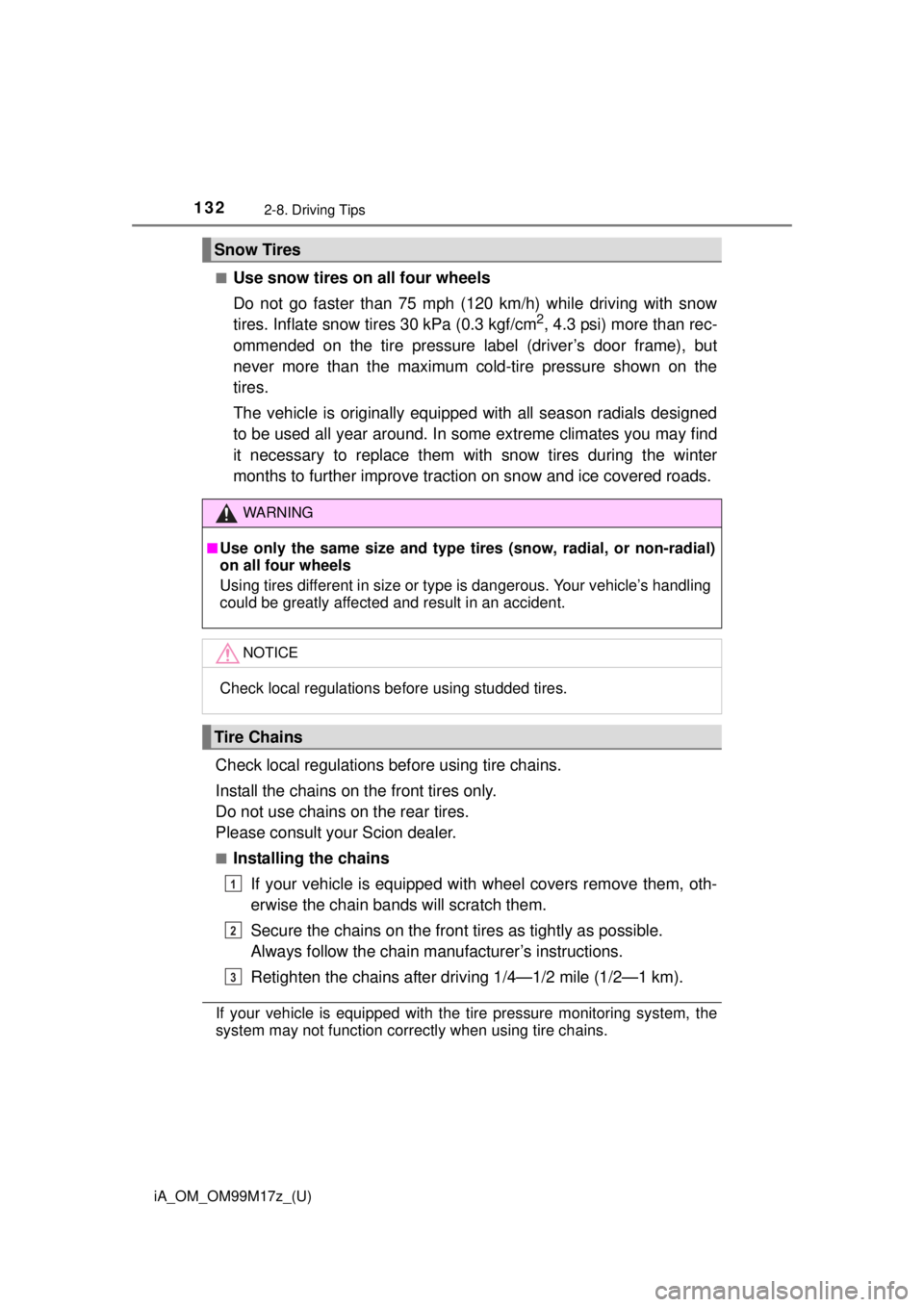
132
iA_OM_OM99M17z_(U)
2-8. Driving Tips
■Use snow tires on all four wheels
Do not go faster than 75 mph (120 km/h) while driving with snow
tires. Inflate snow tires 30 kPa (0.3 kgf/cm
2, 4.3 psi) more than rec-
ommended on the tire pressure label (driver’s door frame), but
never more than the maximum cold-tire pressure shown on the
tires.
The vehicle is originally equipped with all season radials designed
to be used all year around. In some extreme climates you may find
it necessary to replace them with snow tires during the winter
months to further improve traction on snow and ice covered roads.
Check local regulations bef ore using tire chains.
Install the chains on the front tires only.
Do not use chains on the rear tires.
Please consult your Scion dealer.
■Installing the chains If your vehicle is equipped with wheel covers remove them, oth-
erwise the chain bands will scratch them.
Secure the chains on the front tires as tightly as possible.
Always follow the chain manufacturer’s instructions.
Retighten the chains after driving 1/4—1/2 mile (1/2—1 km).
If your vehicle is equipped with the tire pressure monitoring system, the
system may not function correctly when using tire chains.
Snow Tires
WARNING
■Use only the same size and type tires (snow, radial, or non-radial)
on all four wheels
Using tires different in size or type is dangerous. Your vehicle’s handling
could be greatly affected and result in an accident.
NOTICE
Check local regulations before using studded tires.
Tire Chains
1
2
3
Page 219 of 588

iA_OM_OM99M17z_(U)
2193-12. Tire Pressure Monitoring System
3
When Driving
Because this system detects slight changes in tire conditions, the timing
of the warning may be faster or slower in the following cases:
●The size, manufacturer, or the type of tires is different from the specifica-
tion.
●The size, manufacturer, or the type of a tire is different from the others,
or the level of tire wear is excessively different between them.
●A run-flat tire, studless tire, snow tire, or tire chains are used.
●An emergency tire is used (The tire pressure monitoring system warning
light may flash and then continue illuminating).
●A tire is repaired using the emergency flat tire repair kit.
●The tire pressure is excessively hi gher than the specified pressure, or
the tire pressure is suddenly lowered for some reason such as a tire
burst during driving.
●The vehicle speed is lower than about 9.3 mph (15 km/h) (including
when the vehicle is stopped), or t he drive period is shorter than 5 min-
utes.
●The vehicle is driven on an extremely rough road or a slippery, icy road.
●Hard steering and rapid acceleration/deceleration are repeated such as
during aggressive driving on a winding road.
●Load on the vehicle is applied to a tire such as by loading heavy luggage
to one side of the vehicle.
●System initialization has not been im plemented with the specified tire
pressure.
Page 298 of 588
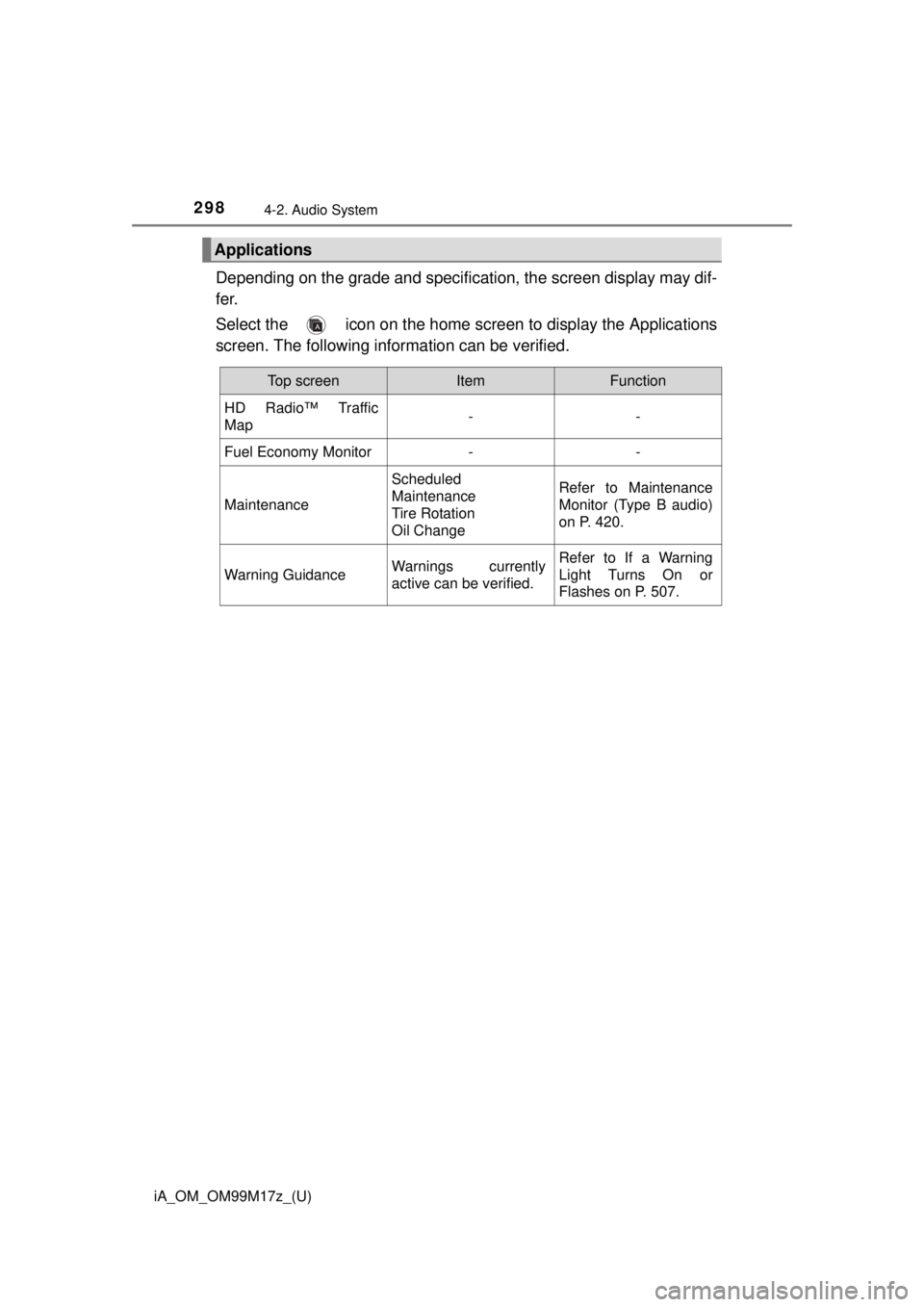
298
iA_OM_OM99M17z_(U)
4-2. Audio System
Depending on the grade and specification, the screen display may dif-
fer.
Select the icon on the home screen to display the Applications
screen. The following information can be verified.
Applications
Top screenItemFunction
HD Radio™ Traffic
Map--
Fuel Economy Monitor--
Maintenance
Scheduled
Maintenance
Tire Rotation
Oil ChangeRefer to Maintenance
Monitor (Type B audio)
on P. 420.
Warning GuidanceWarnings currently
active can be verified.Refer to If a Warning
Light Turns On or
Flashes on P. 507.
Page 341 of 588
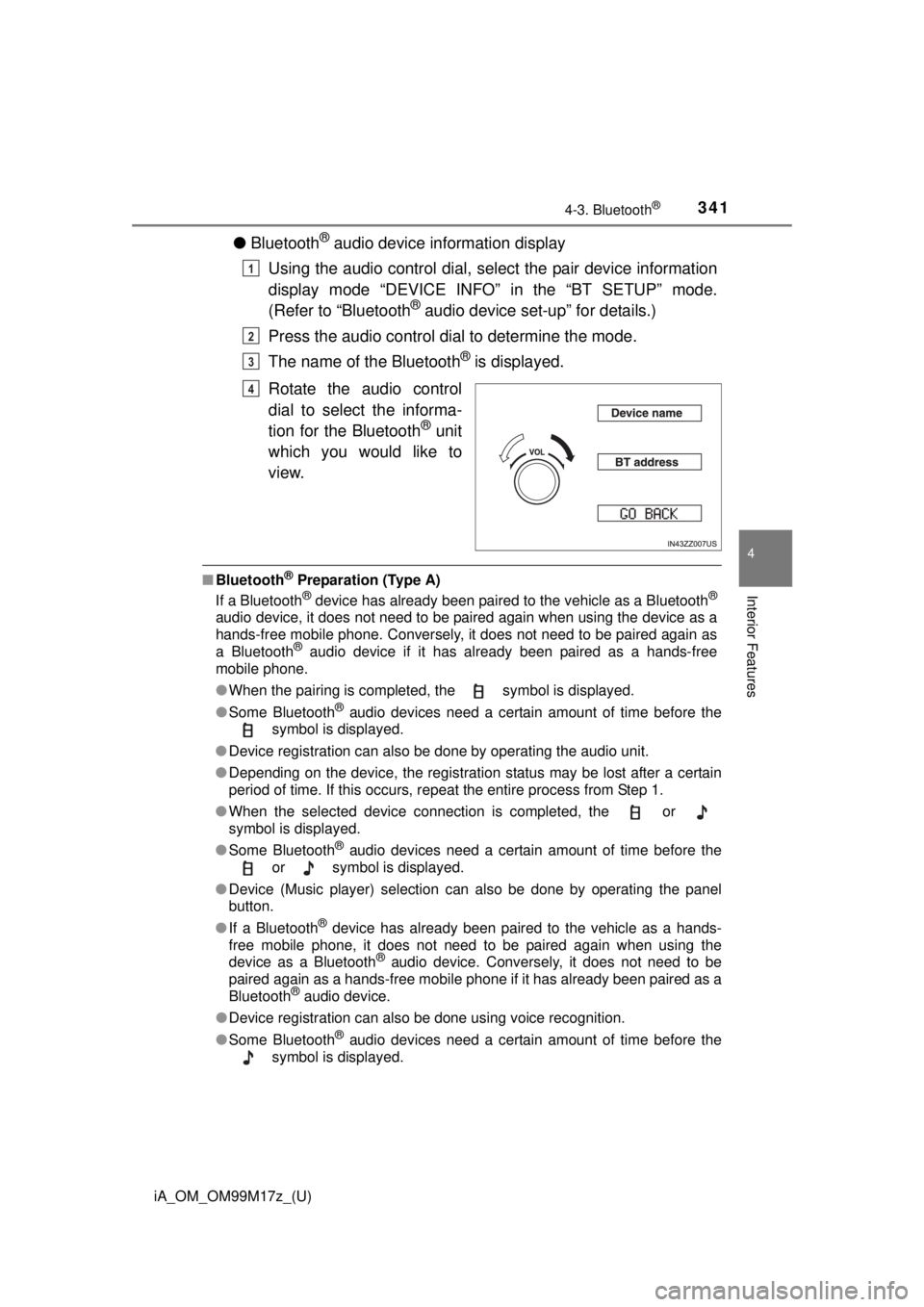
iA_OM_OM99M17z_(U)
3414-3. Bluetooth®
4
Interior Features
●Bluetooth® audio device information display
Using the audio control dial, sele ct the pair device information
display mode “DEVICE INFO” in the “BT SETUP” mode.
(Refer to “Bluetooth
® audio device set-up” for details.)
Press the audio control dial to determine the mode.
The name of the Bluetooth
® is displayed.
Rotate the audio control
dial to select the informa-
tion for the Bluetooth
® unit
which you would like to
view.
■ Bluetooth® Preparation (Type A)
If a Bluetooth® device has already been paired to the vehicle as a Bluetooth®
audio device, it does not need to be paired again when using the device as a
hands-free mobile phone. Conversely, it does not need to be paired again as
a Bluetooth
® audio device if it has already been paired as a hands-free
mobile phone.
● When the pairing is completed, the symbol is displayed.
● Some Bluetooth
® audio devices need a certain amount of time before the
symbol is displayed.
● Device registration can also be done by operating the audio unit.
● Depending on the device, the registration status may be lost after a certain
period of time. If this occurs, repeat the entire process from Step 1.
● When the selected device connection is completed, the or
symbol is displayed.
● Some Bluetooth
® audio devices need a certain amount of time before the
or symbol is displayed.
● Device (Music player) selection can also be done by operating the panel
button.
● If a Bluetooth
® device has already been paired to the vehicle as a hands-
free mobile phone, it does not need to be paired again when using the
device as a Bluetooth
® audio device. Conversely, it does not need to be
paired again as a hands-free mobile phone if it has already been paired as a
Bluetooth
® audio device.
● Device registration can also be done using voice recognition.
● Some Bluetooth
® audio devices need a certain amount of time before the
symbol is displayed.
1
2
3
4
Page 446 of 588
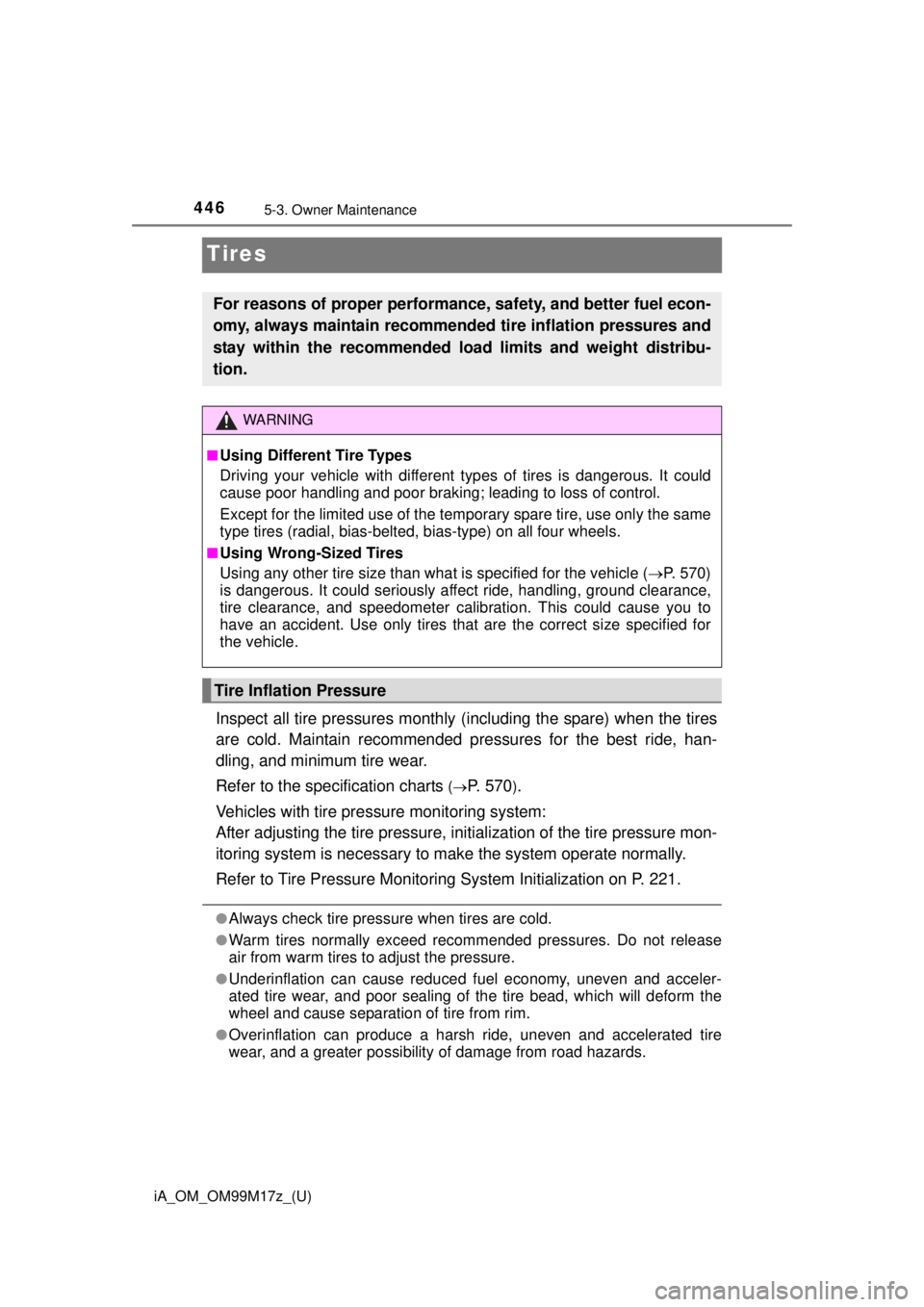
446
iA_OM_OM99M17z_(U)
5-3. Owner Maintenance
Tires
Inspect all tire pressures monthly (including the spare) when the tires
are cold. Maintain recommended pressures for the best ride, han-
dling, and minimum tire wear.
Refer to the specification charts
( P. 570).
Vehicles with tire pres sure monitoring system:
After adjusting the tire pressure, initialization of the tire pressure mon-
itoring system is necessary to make the system operate normally.
Refer to Tire Pressure Monitoring System Initialization on P. 221.
●Always check tire pressure when tires are cold.
●Warm tires normally exceed recommended pressures. Do not release
air from warm tires to adjust the pressure.
●Underinflation can cause reduced fuel economy, uneven and acceler-
ated tire wear, and poor sealing of the tire bead, which will deform the
wheel and cause separation of tire from rim.
●Overinflation can produce a harsh ride, uneven and accelerated tire
wear, and a greater po ssibility of damage from road hazards.
For reasons of proper performance, safety, and better fuel econ-
omy, always maintain recommended tire inflation pressures and
stay within the recommended lo ad limits and weight distribu-
tion.
WARNING
■Using Different Tire Types
Driving your vehicle with different ty pes of tires is dangerous. It could
cause poor handling and poor braking; leading to loss of control.
Except for the limited use of the temporary spare tire, use only the same
type tires (radial, bias-belted, bias-type) on all four wheels.
■Using Wrong-Sized Tires
Using any other tire size than what is specified for the vehicle (P. 570)
is dangerous. It could seriously affect ride, handling, ground clearance,
tire clearance, and speedometer calibration. This could cause you to
have an accident. Use only tires that are the correct size specified for
the vehicle.
Tire Inflation Pressure
Page 450 of 588
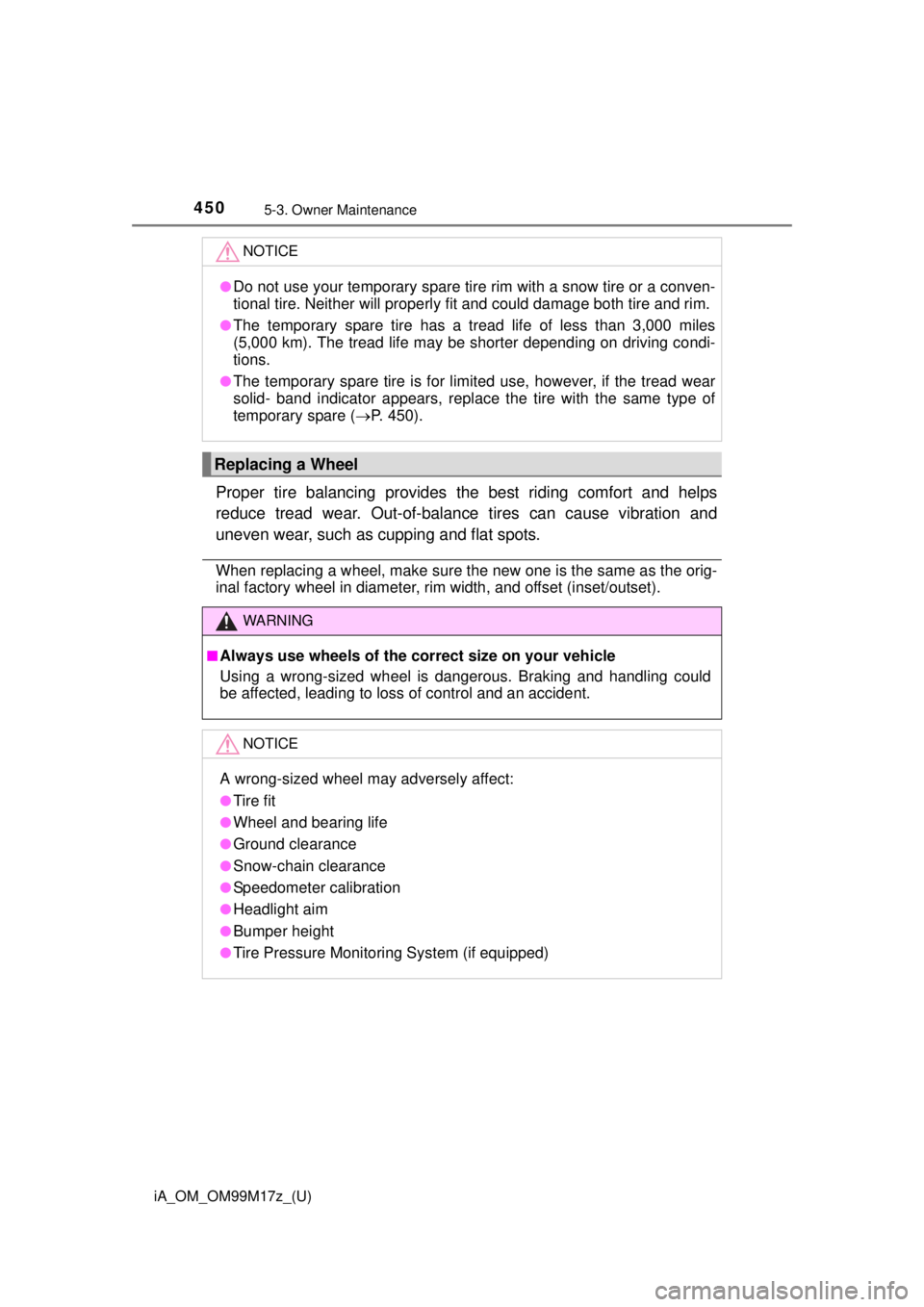
4505-3. Owner Maintenance
iA_OM_OM99M17z_(U)
Proper tire balancing provides the best riding comfort and helps
reduce tread wear. Out-of-balance tires can cause vibration and
uneven wear, such as cupping and flat spots.
When replacing a wheel, make sure the new one is the same as the orig-
inal factory wheel in diameter, rim width, and offset (inset/outset).
NOTICE
●Do not use your temporary spare tire rim with a snow tire or a conven-
tional tire. Neither will properly fit and could damage both tire and rim.
●The temporary spare tire has a tread life of less than 3,000 miles
(5,000 km). The tread life may be shorter depending on driving condi-
tions.
●The temporary spare tire is for limited use, however, if the tread wear
solid- band indicator appears, replace the tire with the same type of
temporary spare ( P. 450).
Replacing a Wheel
WARNING
■Always use wheels of the correct size on your vehicle
Using a wrong-sized wheel is dangerous. Braking and handling could
be affected, leading to loss of control and an accident.
NOTICE
A wrong-sized wheel may adversely affect:
●Tire fit
●Wheel and bearing life
●Ground clearance
●Snow-chain clearance
●Speedometer calibration
●Headlight aim
●Bumper height
●Tire Pressure Monitoring System (if equipped)
Page 518 of 588
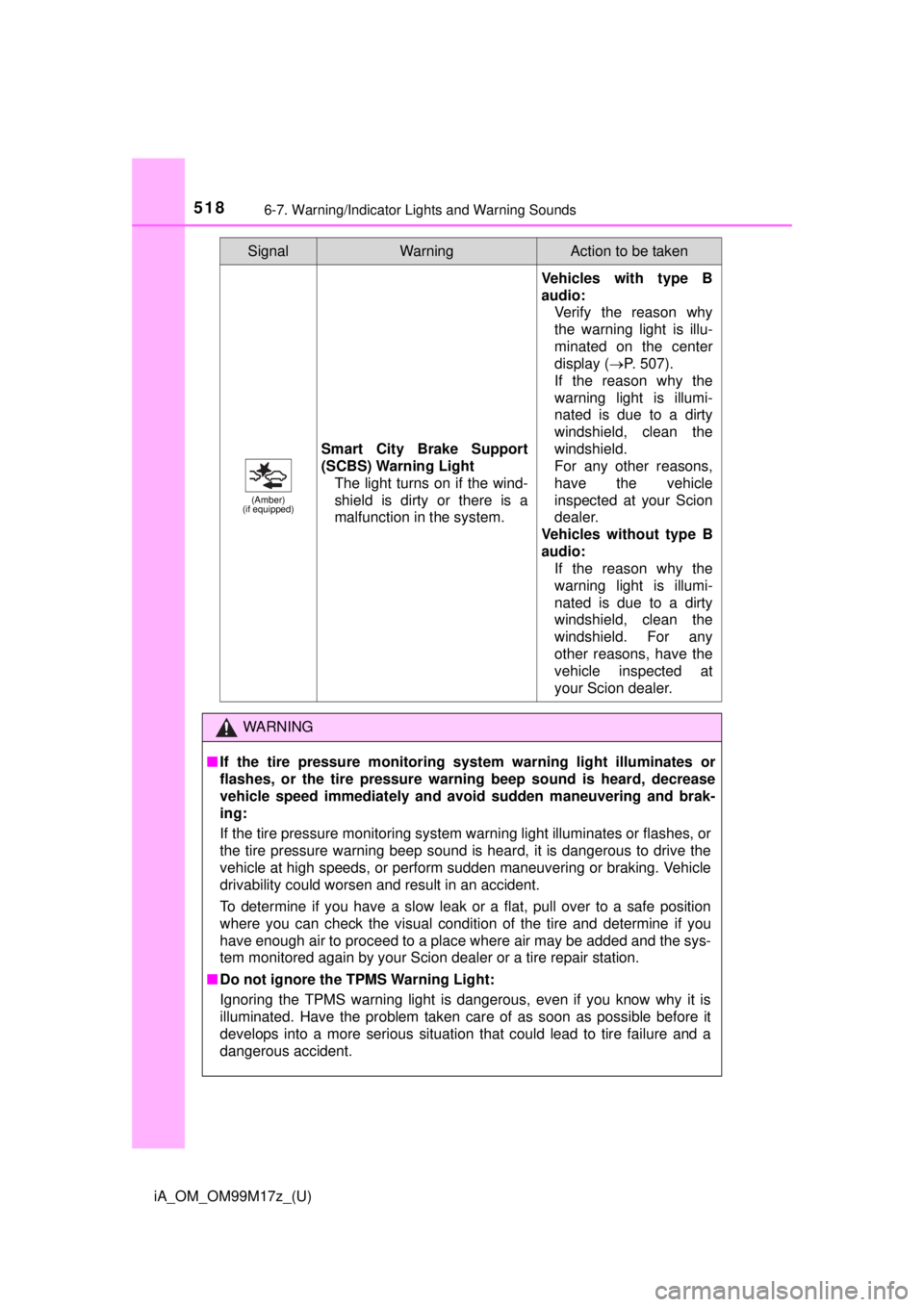
5186-7. Warning/Indicator Lights and Warning Sounds
iA_OM_OM99M17z_(U)
(Amber)
(if equipped)
Smart City Brake Support
(SCBS) Warning Light
The light turns on if the wind-
shield is dirty or there is a
malfunction in the system.
Vehicles with type B
audio:Verify the reason why
the warning light is illu-
minated on the center
display ( P. 507).
If the reason why the
warning light is illumi-
nated is due to a dirty
windshield, clean the
windshield.
For any other reasons,
have the vehicle
inspected at your Scion
dealer.
Vehicles without type B
audio: If the reason why the
warning light is illumi-
nated is due to a dirty
windshield, clean the
windshield. For any
other reasons, have the
vehicle inspected at
your Scion dealer.
WARNING
■If the tire pressure monitoring system warning light illuminates or
flashes, or the tire pressure warn ing beep sound is heard, decrease
vehicle speed immediately and avoid sudden maneuvering and brak-
ing:
If the tire pressure monitoring system warning light illuminates or flashes, or
the tire pressure warning beep sound is heard, it is dangerous to drive the
vehicle at high speeds, or perform sudden maneuvering or braking. Vehicle
drivability could worsen and result in an accident.
To determine if you have a slow leak or a flat, pull over to a safe position
where you can check the visual condition of the tire and determine if you
have enough air to proceed to a place where air may be added and the sys\
-
tem monitored again by your Scion dealer or a tire repair station.
■ Do not ignore the TPMS Warning Light:
Ignoring the TPMS warning light is dangerous, even if you know why it is
illuminated. Have the problem taken care of as soon as possible before it
develops into a more serious situation that could lead to tire failure and a
dangerous accident.
SignalWarningAction to be taken
Page 544 of 588

544
iA_OM_OM99M17z_(U)
7-7. Tire Information (U.S.A.)
■Maximum Load Rating
This number indicates the maximum load in kilograms and pounds
that can be carried by the tire.
■Maximum Permissible Inflation Pressure
This number is the greatest amount of air pressure that should ever
be put in the tire under normal driving conditions.
■Tread Wear, Traction and Temperature Grades
● Tread wear: The tread wear grade is a comparative rating based
on the wear rate of the tire wh en tested under controlled condi-
tions on a specified government te st course. For example, a tire
graded 150 would wear one and one-half (1 1/2) times as well on
the government course as a tire graded 100.
● Traction: The traction grades, from highest to lowest are AA, A,
B, and C. The grades represent the tire’s ability to stop on wet
pavement as measured under cont rolled conditions on specified
government test surfaces of as phalt and concrete. A tire marked
C may have poor traction performance.
● Temperature: The temperature gra des are A (the highest), B and
C, representing the tire’s resistance to the generation of heat and
its ability to dissipate heat when tested under controlled condi-
tions on a specified indoor laboratory test wheel.
■Snow Tires
In some heavy snow areas, local governments may require true
snow tires, those with very deeply cut tread. These tires should only
be used in pairs or placed on all four wheels. Make sure you pur-
chase snow tires that are the same size and construction type as
the other tires on your vehicle.
■SAFETY WARNING
The following safety warning appears on the tire’s sidewall. SERI-
OUS INJURY MAY RESULT FROM: • EXPLOSION OF TIRE/RIM ASSEMBLY DUE TO IMPROPER MOUNTING-MATCH TIRE DIAMETER TO RIM DIAMETER;
NEVER EXCEED 40 psi (275 kPa) TO SEAT BEADS-ONLY
SPECIALLY TRAINED PERSONS SHOULD MOUNT TIRES.
• TIRE FAILURE DUE TO UNDER-INFLATION/OVERLOADING/ DAMAGE- FOLLOW OWNER’S MANUAL AND PLACARD IN
VEHICLE-FREQUENTLY CHECK INFLATION PRESSURE AND
INSPECT FOR DAMAGE.
Page 571 of 588
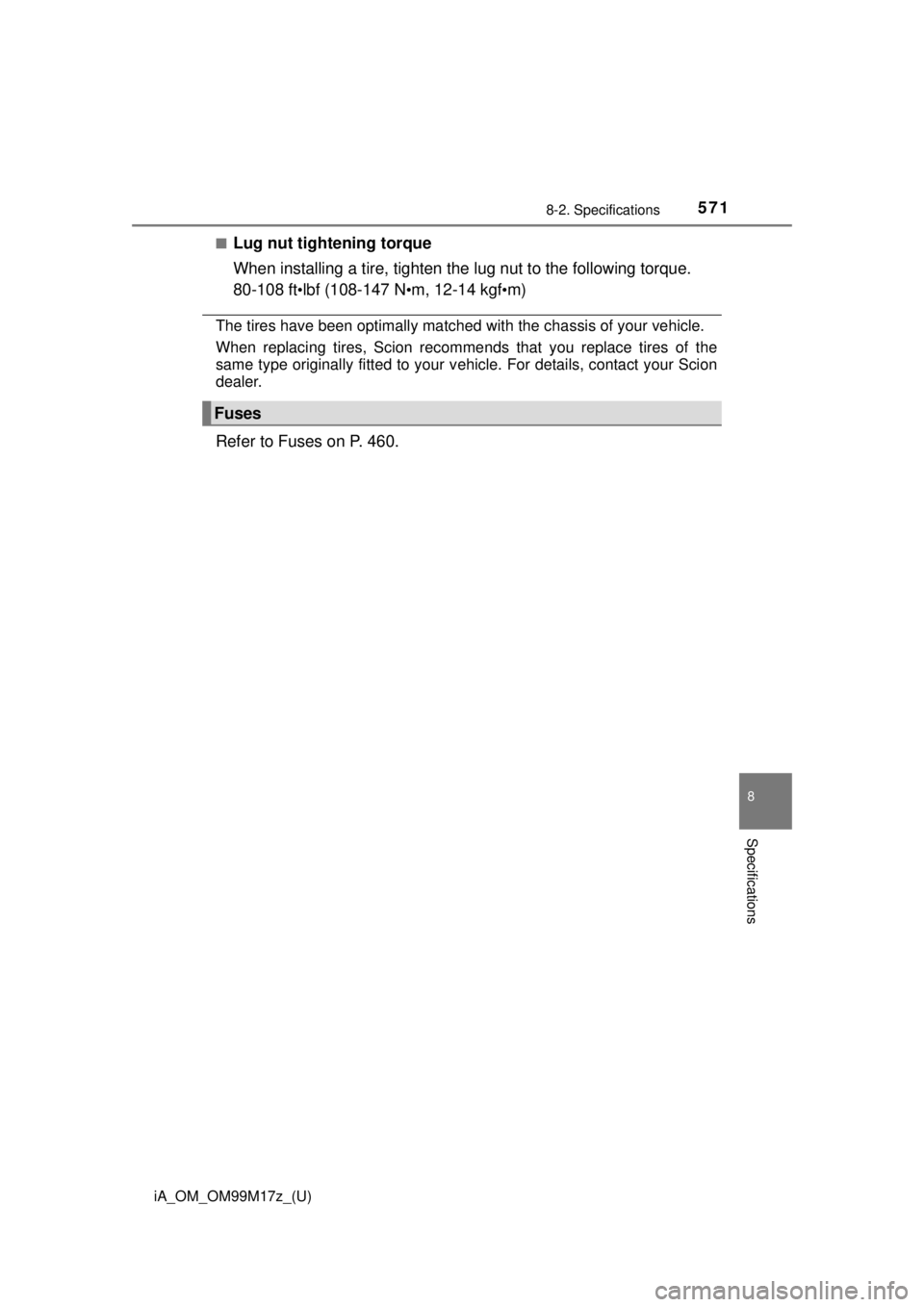
5718-2. Specifications
iA_OM_OM99M17z_(U)
8
Specifications
■Lug nut tightening torque
When installing a tire, tighten the lug nut to the following torque.
80-108 ft
•lbf (108-147 N•m, 12-14 kgf•m)
The tires have been opti mally matched with the ch assis of your vehicle.
When replacing tires, Scion recommends that you replace tires of the
same type originally fitted to your v ehicle. For details, contact your Scion
dealer.
Refer to Fuses on P. 460.
Fuses